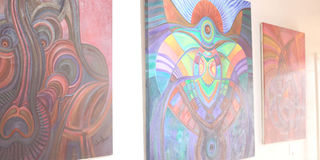Prime
All the right strokes with local art masters

Crested Crane, one of Godfrey Banadda’s artworks. PHOTO/andrew kaggwa
What you need to know:
Godfrey Banadda stands out as a colourist, as colour turns out to be the dominant feature of his consequential work. Dr Maria Kizito is mainly known for his work as a sculptor. The two artists have experimented with many techniques, themes, and materials as they have been progressing through the years.
It is not everyday that local masters of art showcase work. And this is not about one art master, but about two of them showcasing some of their huge collections with a hint of new works.
Yet, this is exactly what happened at Umoja Gallery in Bukoto, two artists with vast experience and ranging techniques, Dr Maria Kizito and Godfrey Banadda, came together for an exhibition. Aptly titled Strokes of Splendour, the exhibition, according to Jude Katete, who wrote the exhibition description, presents the themes and ideas of two eminent local masters, Kizito Maria Kasule and Godfrey Banadda.
Their intellectual fervour matches their artistic energy, and the social commentary and emotions evoked in their work are based on their reflective spirit.
The two artists have worked for a long time and with their experience, they have experimented with many techniques, themes, and materials as they have been progressing through the years. Banadda stands out as a colourist. Colour is a dorminant feature in all her work. The Colour Field painting style that emerged in New York City in the 1940s and 1950s, liberated colour from the objective context and turned it into the subject of interest.
On the other hand, Kizito has honed his skill through experimental practises. He is mainly known for his work as a sculptor and in the exhibition, he proved yet again that he could be a master of multi disciplines.
According to Lyton Hillary, the co-founder of Umoja Gallery and curator of the exhibition, masters such as Kizito and Banadda rarely showcase in galleries. “There are many spaces that are concentrating on novice artists,” she says. Having icons such as Banada and Kizito helps the current crop of artists to learn from them and collaborate. Above all, there are collectors waiting for their works,” she says.
And they did not disappoint, whether it was Banadda tackling addiction, a woman’s character to documenting the Kabaka of Buganda, Banadda did remained colourful even when he was being minimalist.
Kizito’s work delves into topics of freedom and identity. He uses identical figures and patterns in a series of works to preach togetherness and hope. Kizito’s work is very colourful, and yet, like many of the artists of his time, he’s clean with the brushes.
But there is more to the works of the two artists. At the time the exhibition was up, collectors, scholars, and their former students flocked to the gallery to order artworks. Their works have been produced over a long time, with the oldest painting in the exhibition being as old as 24 years.
The painting, The King (Power Devolution), was initially done by Banada in 2,000 and explains the supremacy of the Kabaka, noting that he is third in the hierarchy that includes Tonda and Lubaale.
“Coming to Buganda, Kintu (First King of Buganda), came with gods led by the arch god Bukulu. Bukulu did not settle in Buganda, but continued to Ssese islands with gods such as Mukasa, Musisi and Wannema. Those gods who did not proceed to Ssese with Bukulu, settled in Buganda and occupied conspicuous high hills around the region known as Muwawa then,” reads a note on the painting.
The painting documentation talks about the spirituality of the Kabaka and how many of the hills in the kingdom got their names. Kizito however, questions both freedom and hope; in his artwork, Hope, he puts together a painting whose story is continuity of a narrative he starts in Serenity and The Spirits of Innocence.
He questions whether there is hope, but it is not the only thing he interogates with his brush. The masters have sold out the exhibition that some works have been replaced even before the exhibition could close.
Background
Maria Kizito Kasule was born in Masaka, in 1967. He is a very enterprising artist. He studied at Makerere University at the Margaret Trowell School of Fine Art, where he got his bachelor’s degree. He also earned a Master’s degree in Fine Art, and a PhD in Art History from Makerere University.
He won a scholarship to Burren College of Art in Ireland. He has taught at Makerere University for years and rose through the ranks to become an associate professor and the deputy principal of the College of Engineering, Design, Art and Technology (CEDAT). He is a founding director of Nagenda International Academy of Art and Design (NIAAD).
He is a prolific artist and has held a number of solo and group exhibitions around the world. Maria Kizito Kasule fits the description of an “artist as a public intellectual.’’ Born in 1958, Godfrey Banadda studied Fine Art at Makerere University’s Margaret Trowell School of Fine Art for his undergraduate and postgraduate studies and he taught at the same institution for a number of years.
Notably, during his undergraduate studies, he went through the guidance of Prof Francis Nnaggenda, Prof Francis Musango Gwantamu, Mulindwa Peter, Ignatius Serulyo, Josephine Mukasa, Ochiti Santos, and Fabian Mpagi. He worked for some time outside academia before he subsequently embarked on an academic career at Makerere University for more than two decades. He distinguished himself as an academic, a prize winner of a number of art competitions, and a prolific painter.
Additional reporting from Umoja Catalogue




